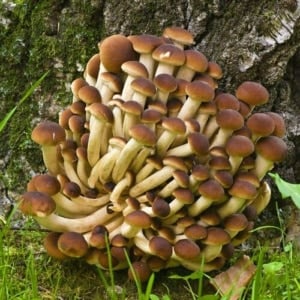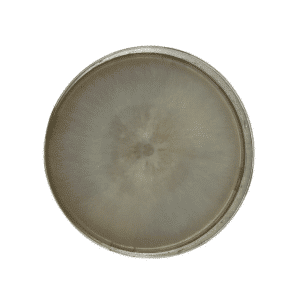Showing all 5 resultsSorted by popularity
Sword Belt Mushroom (Agrocybe aegerita)
Sword Belt Mushroom (Agrocybe aegerita), also known as Pioppino, is an edible mushroom highly regarded for its flavor and unique appearance. The Sword Belt Mushroom is a popular choice among gourmet chefs and restaurant customers due to its savory taste and velvety texture. It belongs to the genus Agrocybe and is found in regions with a temperate climate, typically growing on hardwoods.
Species Description: Agrocybe aegerita
The Sword Belt Mushroom is scientifically known as Agrocybe aegerita, but it is also commonly referred to as Pioppino. This species is highly sought after due to its delightful flavor and elegant structure. When fresh, these mushrooms grow in tight clusters with long stems, and their caps are a rich, velvety brown. The color of the caps can be influenced by light exposure during cultivation. For instance, exposure to light results in darker, brownish caps, while mushrooms grown in the absence of light may develop pale or even white caps. This variability in cap color adds to the aesthetic appeal of the Pioppino mushroom.
In terms of texture, Sword Belt Mushrooms offer a dense and slightly chewy bite, making them ideal for a wide variety of dishes. Their stems are long and fibrous, while their caps provide a tender, yet firm texture that holds up well in cooking.
Preferred Substrate for Sword Belt Mushrooms
The cultivation of Sword Belt Mushrooms requires specific substrates to ensure optimal growth. These mushrooms prefer hardwood sawdust as their primary growing medium. Hardwood is ideal because it mimics the natural environment in which these mushrooms thrive, typically on the decaying wood of hardwood trees. For those looking to achieve higher yields and larger clusters, a supplemented substrate is recommended. The Masters Mix, a combination of hardwood sawdust and soybean hulls, is particularly effective for cultivating Agrocybe aegerita. This substrate provides the necessary nutrients and moisture to support healthy and vigorous mushroom growth.
The key to successful Sword Belt Mushroom cultivation is to maintain the right moisture levels and ensure the substrate has the right nutrient balance. The mushrooms absorb nutrients from the substrate through their mycelium, which is the vegetative part of the fungus.
Incubation Process for Agrocybe aegerita
The incubation stage is a critical phase in the growth of Sword Belt Mushrooms. The incubation period can last anywhere from 3 to 4 weeks, depending on the type of substrate used. It’s important to maintain a controlled environment during this period to facilitate proper mycelial colonization.
During incubation, the substrate must be kept at room temperature, which generally ranges from 21°C to 24°C . This temperature range supports the development of the Agrocybe aegerita mycelium. However, cultivators must be cautious not to let the substrate temperature exceed 30°C , as this can inhibit growth or even kill the developing mycelium.
Providing consistent moisture and avoiding excessive temperature fluctuations are essential for ensuring a successful incubation period. At this stage, the substrate becomes fully colonized by the mycelium, preparing the Sword Belt Mushroom for the next growth phase.
Pinning Conditions for Sword Belt Mushrooms
After the incubation phase, Sword Belt Mushrooms enter the pinning stage, where small mushroom “pins” or fruiting bodies begin to form. Pinning is highly sensitive to environmental conditions, and the Agrocybe aegerita species is known to require high humidity for successful pinning.
The ideal temperature for pinning ranges between 15°C and 18°C , with a relative humidity level between 95% and 100%. Maintaining high humidity is crucial during this phase, as Sword Belt Mushrooms need a moisture-rich environment to develop their fruiting bodies. If the humidity level drops below the required range, the pins may dry out and fail to mature into full-grown mushrooms.
Proper air circulation is also important to encourage pinning. However, excessive airflow that reduces humidity levels should be avoided. Keeping a balanced environment ensures that the Sword Belt Mushrooms transition smoothly into the fruiting stage.
Fruiting Conditions for Agrocybe aegerita
The fruiting stage is when the Sword Belt Mushroom grows into its recognizable form, with long stems and brown caps. During this phase, maintaining the correct environmental conditions is essential to achieving healthy and abundant mushroom growth.
The ideal temperature range for fruiting is between 17°C and 21°C , with the optimal range being 18°C to 19°C . The humidity during this phase should be slightly lower than the pinning stage, with an ideal range of 85% to 90% relative humidity.
Agrocybe aegerita also requires specific carbon dioxide (CO2) levels to thrive during fruiting. The CO2 concentration should be kept between 500 and 2000 ppm (parts per million). Maintaining these conditions ensures that the mushrooms grow to their full potential, developing firm stems and well-formed caps.
It’s worth noting that the Sword Belt Mushroom is more sensitive to environmental conditions than other species, requiring more careful monitoring and adjustment throughout the fruiting process.
Culinary Uses of Sword Belt Mushrooms
The Sword Belt Mushroom, or Pioppino, is not only cherished for its appearance but also for its culinary versatility. These mushrooms have a rich, earthy flavor with hints of nuttiness, making them a popular ingredient in gourmet dishes. Their firm texture holds up well in a variety of cooking methods, including sautéing, grilling, and roasting.
In Italian cuisine, Pioppinos are often used in pasta dishes, risottos, and soups. Their umami-rich flavor pairs beautifully with garlic, herbs, and olive oil. Sword Belt Mushrooms can also be used in stir-fries, adding depth and texture to vegetable and meat dishes alike. Due to their dense structure, these mushrooms absorb flavors well, making them a great addition to marinades and broths.
One of the unique features of Pioppinos is that their long stems remain tender and edible even after cooking. This makes them ideal for adding both flavor and visual appeal to dishes. Chefs often use the whole mushroom, including the cap and stem, to create elegant presentations.
Conclusion
The Sword Belt Mushroom (Agrocybe aegerita), also known as Pioppino, is a highly sought-after species in the culinary world. Its rich flavor, unique appearance, and versatility in cooking make it a prized ingredient. However, cultivating this mushroom requires careful attention to environmental conditions, especially humidity, temperature, and substrate quality. By understanding the specific needs of the Agrocybe aegerita throughout its life cycle—from incubation to fruiting—growers can achieve optimal yields.
Whether you’re a mushroom enthusiast looking to grow your own or a chef aiming to create exquisite dishes, the Sword Belt Mushroom offers a world of possibilities. Its delightful flavor and dense texture make it a standout in any culinary creation.
FAQs
Once colonization is complete, cut slits in the top of your mushroom grow bag to facilitate air exchange and move it to a cooler area with indirect light and higher humidity (around 85%). Mist the inside lightly if needed to maintain humidity, and after a few days, small mushrooms should start to form. Allow them to grow until they reach your desired size, then harvest by twisting gently at the base. Continue misting for potential second flushes of mushrooms, and enjoy your homegrown Swordbelt mushrooms!
Although it may seem like gold tops mushrooms to a beginner, Swordbelt is not a magic mushroom.
Pioppino mushrooms, or Sword Belt Mushrooms, require specific environmental conditions for fruiting. The ideal fruiting temperature is between 17°C and 21°C , with the best results achieved around 18°C to 19°C . Fruiting humidity should be kept at 85% to 90% relative humidity to maintain moisture levels, and the CO2 concentration should range between 500 and 2000 ppm. These conditions ensure that the mushrooms develop healthy, well-formed stems and caps, with a firm texture and optimal flavor.
The Sword Belt Mushroom has a rich, earthy flavor with subtle nutty undertones. Its taste is often described as umami, which adds depth to various dishes. The texture of the mushroom is firm and slightly chewy, making it an ideal ingredient for sautéing, grilling, and adding to soups or pasta. Unlike some other mushrooms, the stems of the Pioppino remain tender after cooking, making the entire mushroom—both stem and cap—delicious and enjoyable to eat.
The Sword Belt Mushroom, scientifically known as Agrocybe aegerita, is a type of edible mushroom commonly referred to as Pioppino. It is a gourmet mushroom highly prized for its delicious flavor and distinctive appearance. Sword Belt Mushrooms grow in clusters, featuring long, slender stems and small, velvety brown caps. These mushrooms are typically found on decaying hardwood trees and are popular in many cuisines, especially in Italian dishes. Due to their rich, earthy flavor and firm texture, they are a favorite among chefs and mushroom enthusiasts.
Yes, Swordbelt mushrooms are edible, but like any mushrooms, cook them properly.



